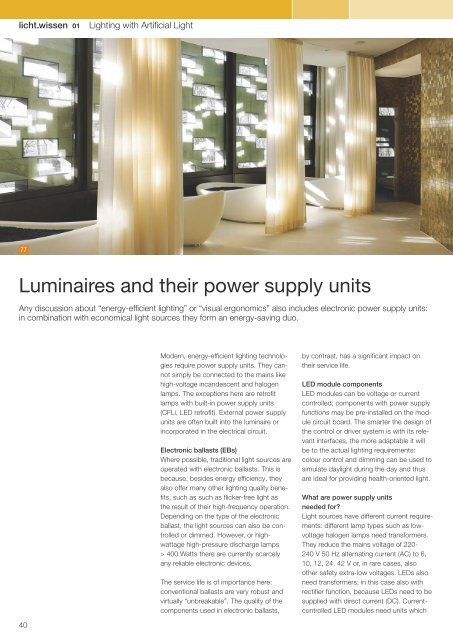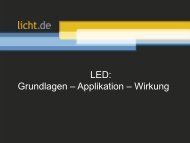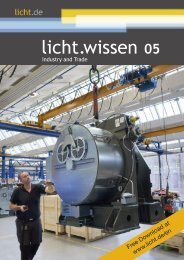licht.wissen No. 01 "Lighting with Artificial Light"
Booklet 1 is intended for all those who want to delve into the topic of light and lighting or wish to familiarize themselves with the basics of lighting technology. It also helps to make a decision in the field of lighting. Free Download at www.licht.de/en
Booklet 1 is intended for all those who want to delve into the topic of light and lighting or wish to familiarize themselves with the basics of lighting technology. It also helps to make a decision in the field of lighting. Free Download at www.licht.de/en
Create successful ePaper yourself
Turn your PDF publications into a flip-book with our unique Google optimized e-Paper software.
<strong>licht</strong>.<strong>wissen</strong> <strong>01</strong><br />
<strong>Lighting</strong> <strong>with</strong> <strong>Artificial</strong> Light<br />
77<br />
Luminaires and their power supply units<br />
Any discussion about “energy-efficient lighting” or “visual ergonomics” also includes electronic power supply units:<br />
in combination <strong>with</strong> economical light sources they form an energy-saving duo.<br />
Modern, energy-efficient lighting technologies<br />
require power supply units. They cannot<br />
simply be connected to the mains like<br />
high-voltage incandescent and halogen<br />
lamps. The exceptions here are retrofit<br />
lamps <strong>with</strong> built-in power supply units<br />
(CFLi, LED retrofit). External power supply<br />
units are often built into the luminaire or<br />
incorporated in the electrical circuit.<br />
Electronic ballasts (EBs)<br />
Where possible, traditional light sources are<br />
operated <strong>with</strong> electronic ballasts. This is<br />
because, besides energy efficiency, they<br />
also offer many other lighting quality benefits,<br />
such as such as flicker-free light as<br />
the result of their high-frequency operation.<br />
Depending on the type of the electronic<br />
ballast, the light sources can also be controlled<br />
or dimmed. However, or highwattage<br />
high-pressure discharge lamps<br />
> 400 Watts there are currently scarcely<br />
any reliable electronic devices.<br />
The service life is of importance here:<br />
conventional ballasts are very robust and<br />
virtually “unbreakable”. The quality of the<br />
components used in electronic ballasts,<br />
by contrast, has a significant impact on<br />
their service life.<br />
LED module components<br />
LED modules can be voltage or current<br />
controlled; components <strong>with</strong> power supply<br />
functions may be pre-installed on the module<br />
circuit board. The smarter the design of<br />
the control or driver system is <strong>with</strong> its relevant<br />
interfaces, the more adaptable it will<br />
be to the actual lighting requirements:<br />
colour control and dimming can be used to<br />
simulate daylight during the day and thus<br />
are ideal for providing health-oriented light.<br />
What are power supply units<br />
needed for?<br />
Light sources have different current requirements:<br />
different lamp types such as lowvoltage<br />
halogen lamps need transformers.<br />
They reduce the mains voltage of 220-<br />
240 V 50 Hz alternating current (AC) to 6,<br />
10, 12, 24, 42 V or, in rare cases, also<br />
other safety extra-low voltages. LEDs also<br />
need transformers; in this case also <strong>with</strong><br />
rectifier function, because LEDs need to be<br />
supplied <strong>with</strong> direct current (DC). Currentcontrolled<br />
LED modules need units which<br />
40

















